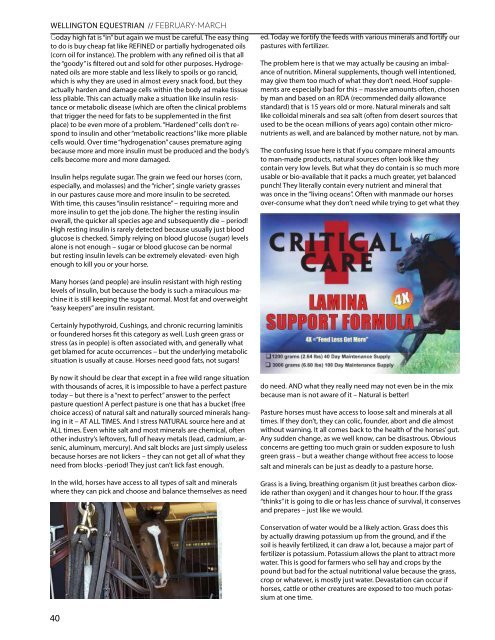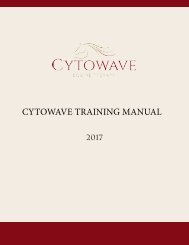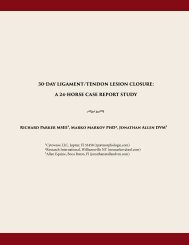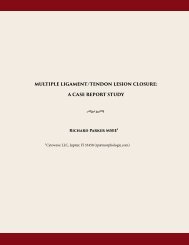Wellington Equestrian cover Feb - March
Create successful ePaper yourself
Turn your PDF publications into a flip-book with our unique Google optimized e-Paper software.
WELLINGTON EQUESTRIAN // FEBRUARY-MARCH<br />
Goday high fat is “in” but again we must be careful. The easy thing<br />
to do is buy cheap fat like REFINED or partially hydrogenated oils<br />
(corn oil for instance). The problem with any refined oil is that all<br />
the “goody” is filtered out and sold for other purposes. Hydrogenated<br />
oils are more stable and less likely to spoils or go rancid,<br />
which is why they are used in almost every snack food, but they<br />
actually harden and damage cells within the body ad make tissue<br />
less pliable. This can actually make a situation like insulin resistance<br />
or metabolic disease (which are often the clinical problems<br />
that trigger the need for fats to be supplemented in the first<br />
place) to be even more of a problem. “Hardened” cells don’t respond<br />
to insulin and other “metabolic reactions” like more pliable<br />
cells would. Over time “hydrogenation” causes premature aging<br />
because more and more insulin must be produced and the body’s<br />
cells become more and more damaged.<br />
Insulin helps regulate sugar. The grain we feed our horses (corn,<br />
especially, and molasses) and the “richer”, single variety grasses<br />
in our pastures cause more and more insulin to be secreted.<br />
With time, this causes “insulin resistance” – requiring more and<br />
more insulin to get the job done. The higher the resting insulin<br />
overall, the quicker all species age and subsequently die – period!<br />
High resting insulin is rarely detected because usually just blood<br />
glucose is checked. Simply relying on blood glucose (sugar) levels<br />
alone is not enough – sugar or blood glucose can be normal<br />
but resting insulin levels can be extremely elevated- even high<br />
enough to kill you or your horse.<br />
ed. Today we fortify the feeds with various minerals and fortify our<br />
pastures with fertilizer.<br />
The problem here is that we may actually be causing an imbalance<br />
of nutrition. Mineral supplements, though well intentioned,<br />
may give them too much of what they don’t need. Hoof supplements<br />
are especially bad for this – massive amounts often, chosen<br />
by man and based on an RDA (recommended daily allowance<br />
standard) that is 15 years old or more. Natural minerals and salt<br />
like colloidal minerals and sea salt (often from desert sources that<br />
used to be the ocean millions of years ago) contain other micronutrients<br />
as well, and are balanced by mother nature, not by man.<br />
The confusing issue here is that if you compare mineral amounts<br />
to man-made products, natural sources often look like they<br />
contain very low levels. But what they do contain is so much more<br />
usable or bio-available that it packs a much greater, yet balanced<br />
punch! They literally contain every nutrient and mineral that<br />
was once in the “living oceans”. Often with manmade our horses<br />
over-consume what they don’t need while trying to get what they<br />
Many horses (and people) are insulin resistant with high resting<br />
levels of insulin, but because the body is such a miraculous machine<br />
it is still keeping the sugar normal. Most fat and overweight<br />
“easy keepers” are insulin resistant.<br />
Certainly hypothyroid, Cushings, and chronic recurring laminitis<br />
or foundered horses fit this category as well. Lush green grass or<br />
stress (as in people) is often associated with, and generally what<br />
get blamed for acute occurrences – but the underlying metabolic<br />
situation is usually at cause. Horses need good fats, not sugars!<br />
By now it should be clear that except in a free wild range situation<br />
with thousands of acres, it is impossible to have a perfect pasture<br />
today – but there is a “next to perfect” answer to the perfect<br />
pasture question! A perfect pasture is one that has a bucket (free<br />
choice access) of natural salt and naturally sourced minerals hanging<br />
in it – AT ALL TIMES. And I stress NATURAL source here and at<br />
ALL times. Even white salt and most minerals are chemical, often<br />
other industry’s leftovers, full of heavy metals (lead, cadmium, arsenic,<br />
aluminum, mercury). And salt blocks are just simply useless<br />
because horses are not lickers – they can not get all of what they<br />
need from blocks -period! They just can’t lick fast enough.<br />
In the wild, horses have access to all types of salt and minerals<br />
where they can pick and choose and balance themselves as need<br />
do need. AND what they really need may not even be in the mix<br />
because man is not aware of it – Natural is better!<br />
Pasture horses must have access to loose salt and minerals at all<br />
times. If they don’t, they can colic, founder, abort and die almost<br />
without warning. It all comes back to the health of the horses’ gut.<br />
Any sudden change, as we well know, can be disastrous. Obvious<br />
concerns are getting too much grain or sudden exposure to lush<br />
green grass – but a weather change without free access to loose<br />
salt and minerals can be just as deadly to a pasture horse.<br />
Grass is a living, breathing organism (it just breathes carbon dioxide<br />
rather than oxygen) and it changes hour to hour. If the grass<br />
“thinks” it is going to die or has less chance of survival, it conserves<br />
and prepares – just like we would.<br />
Conservation of water would be a likely action. Grass does this<br />
by actually drawing potassium up from the ground, and if the<br />
soil is heavily fertilized, it can draw a lot, because a major part of<br />
fertilizer is potassium. Potassium allows the plant to attract more<br />
water. This is good for farmers who sell hay and crops by the<br />
pound but bad for the actual nutritional value because the grass,<br />
crop or whatever, is mostly just water. Devastation can occur if<br />
horses, cattle or other creatures are exposed to too much potassium<br />
at one time.<br />
40










